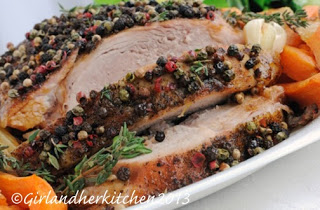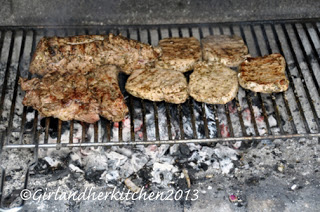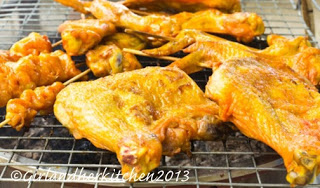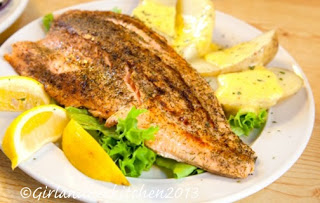Today, we’ll be talking about preparing chicken, pork, and fish on the grill. Let’s start with pork. Referred to as, “the other white meat,” it often gets relegated to the periphery of the meat hierarchy. I think that’s a bit unfair. It is amazing roasted, breaded and fried, and especially on the grill. Pork also takes to sauces with great gusto and brings new life to old dishes.
Due to changes in the raising of pork over the last 30-40 years, it has become a lot leaner than it used to be. These changes have made pork a little more complex to cook. Less fat deposits on the various cuts makes for less moisture, which in turn, leads to a tougher piece of grilled meat If cooked for too long over too high of a heat, you can be wrestling with shoe leather on your plate instead of a juicy, tasty piece of meat. (This is a good tip to remember whether cooking with the grill, stove, or oven.)
Pork also has to be cooked fully. I recommend that you cook it to an internal temperature of about 155 degrees for lean cuts like loins, chops, and tenderloins and 165 degrees for for large cuts like shoulders and hams to ensure you’ve avoided that problem completely. (Bear in mind that meat continues to cook after you take it off the heat, so remove it a little before peak temperatures.)
As for cuts, and how best to grill them, here is a list from most tender to tougher portions and their grilling tips:
Loin: this includes loin roast, chops, center cut chops, tenderloin, back ribs, and country ribs. Loin chops, rib chops, and rack ribs should all be cooked at medium over direct heat. Baby backs, loin roasts, and tenderloins should be cooked at medium over indirect heat.
Leg: this includes ham and ham steaks. Since these are already cooked it is not going to be actually cooked on the grill but, reheated. This should be done over indirect heat and watched so as not to overcook it.
Belly: from the belly you get spareribs. These should be cooked at medium-low over indirect heat.
Shoulder: this is where you will get the butt roast and Country spareribs. For both, cook at medium-low over indirect heat.
Foreleg: this is where you will get the hocks. Cook these at medium over direct heat
* if you should choose to make a suckling pig (whole pig or piglet), it’s best if cooked at medium-low over indirect heat.
Now, let’s talk turkey … and chicken and other poultry. Chicken is a do-all, works-with-almost-any-recipe, versatile meat. It’s always ready to jump in and do its best wherever you decide to use it, making it a must for the grill.
Unlike beef, all chicken is graded for quality. The good news is that almost all the poultry sold in the United States is graded A. This is an indication that the bird is free of defects, rounded, heavy muscled, and has a layer of fat under the skin.
Poultry is classified by species (chicken, turkey, duck…) so that is how I will list them for you.
Chicken: Cornish game hens, broiler/fryer, and roaster.
Cornish game hens: should be cooked at medium over indirect heat if whole and at medium over direct heat for split birds.
Broiler/ fryer: should be cooked at medium over indirect heat whether split or whole. For pieces, I recommend medium over direct heat.
Roaster: Whole or split bird should be cooked at medium over indirect heat; pieces should be cooked at medium over direct heat.
Turkey: Fryer/roaster, young (less than 6 months), yearling (less than 15 months), and mature hen or Tom (more than 15 months).
Fryer roaster: this should be cooked at medium over indirect heat.
Young: this should be cooked at medium over indirect heat.
Yearling: This should be cooked at medium over indirect heat.
Mature hen or Tom: this should be cooked at medium-low over indirect heat.
Duck: Duckling (less than 8 weeks) and roaster
Duckling: the whole or split duckling should be cooked at medium over indirect heat. Pieces should be cooked at medium over direct heat.
Roaster: Whole or split should be cooked at medium over indirect heat. Pieces should be cooked at medium over direct heat.
As for fish, rather than going into each and every kind available, I will offer you some helpful tips on what to look for when buying fish and the different ways it can be prepared.
It doesn’t matter what kind of fish you are looking for, there are a few key things every good piece of fish should have.
1. Fresh fish should have firm flesh. Don’t be afraid to give the fish a little poke. Choose the thickest part of the fish and give it a jab. The flesh should bounce back quickly. If it leaves a dent the flesh is beginning to deteriorate.
2. Lift the gill flaps at the back of the head. The interior gills should be spongy and bright red or pink. Brown or gray indicates it’s not fresh.
3. The eyes should be clear, clean, and bulge slightly. Sunken or cloudy eyes? Say your goodbyes.
4. The skin color should be bright and should have no blemishes or red patches under its surfaces.
5. Fresh fish has no odor at all. It may smell a bit like the ocean but that is all you should smell. A fishy odor indicates the fish is not fresh anymore. Smelling your fish is one of the most accurate ways of testing for freshness.
As far as preparation, here are a number of general ways to get your fish ready for the grill.
Whole dressed: This means the fish has been scaled, gutted, and gills removed. The head and tail stay attached. This style of fish is best prepared over indirect heat. This style is also great stuffed.
Pan dressed: This means the fish is scaled, gutted, and the head is removed. Cook over indirect heat.
Scored: The whole fish, whole or pan-dressed, is slashed along the sides to allow for the heat to permeate and cook faster.
Fillet: The term fillet does not mean that a piece of fish is necessarily boneless. What filleting refers to is that the meat is separated from the backbone and ribcage. If the fish remains connected at the back it is called a butterfly fillet. If it is cut along the back but remains attached at the stomach, ready for stuffing, it’s called a kited fillet.
Split: this term means the fish has been cut into two separated fillets.
Steak: This refers to a cross section of a round body fish that is scaled and gutted. A portion of the backbone remains to hold the meat together. If the steak is horseshoe shaped, it’s from the top of the body, close to the head and is called a center cut. If it’s more of an oval shape it’s cut from the tail or loin. The steak cut is great for grilling because it holds its shape and stays together.
There you have it. Everything you need to know to grill just about anything. So, if your grill, like mine, has been staring at you and mocking you for the foods you’ve burned or let slip through the grates, it’s time to get out there and take that grill on. No more living in fear. You are an informed and ready grilling pro. Now get out there and cook!






Leave a Reply